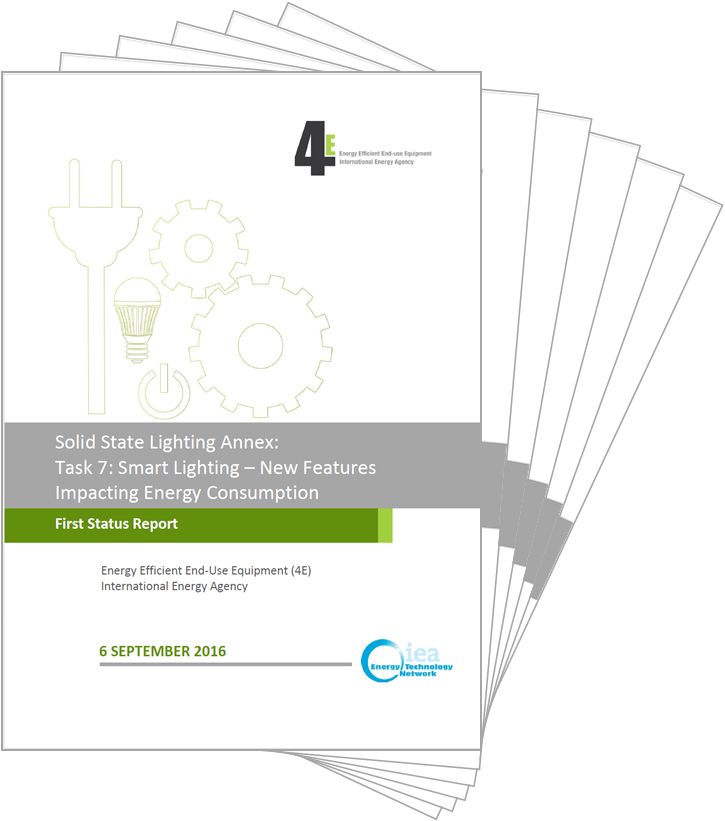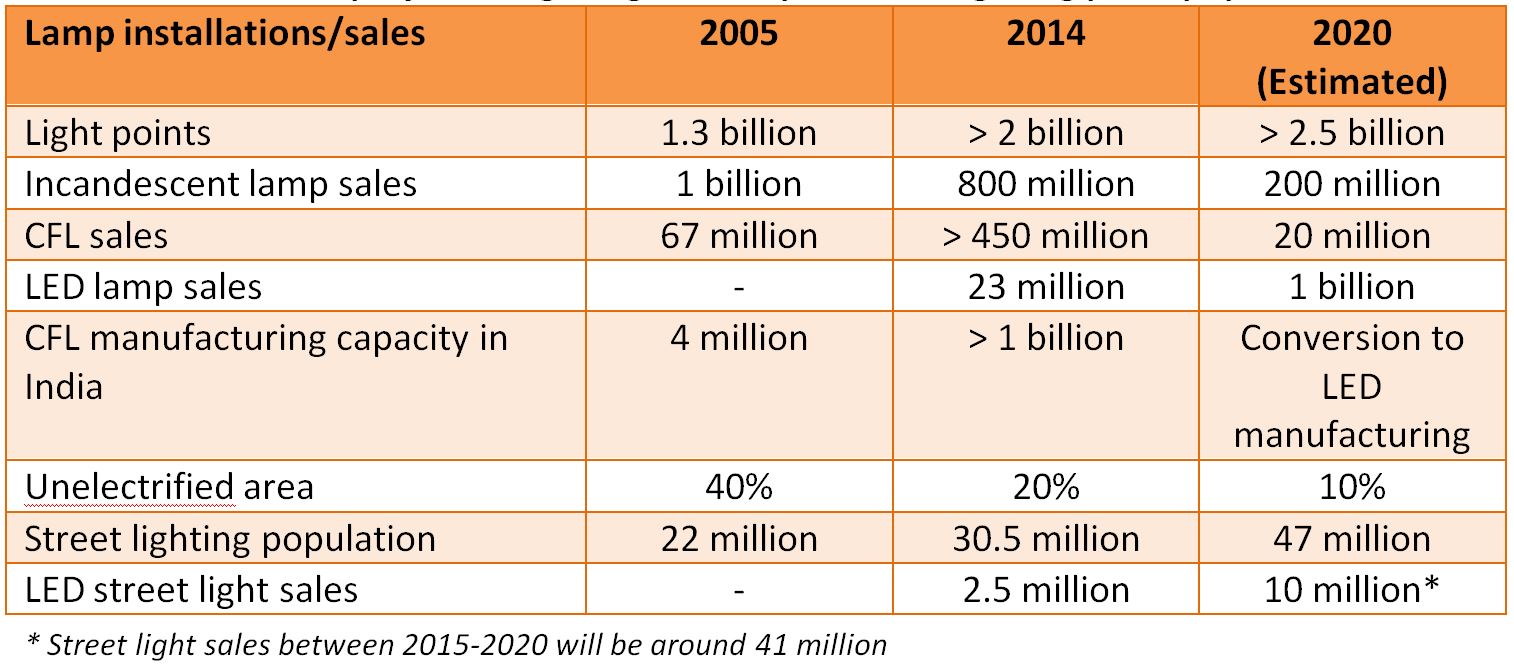In this issue, we provide information on the:
- New Secretariat for lites.asia;
- New report from the IEA 4E SSL Annex on the energy consumption of ‘smart lighting’;
- Recently published results of an Australian household lighting consumer survey and a lighting audit of 180 houses;
- Status of the ASEAN SHINE – Lighting project;
- Progress and projected achievements of energy efficient lighting in India;
- Recent work by the IEC on possible restructuring of TC34;
- Proposed United States standard for general service lamps;
- Tools available from the en.lighten Southeast Asia and Pacific MVE Project;
- SEAD Global Efficiency Medal competition and Global Lighting Challenge.
Transition of lites.asia management and secretariat services
Since March 2014, lites.asia has been managed by the United Nations Environment Programme en.lighten initiative as part of the Australian Government funded Southeast Asia and Pacific Monitoring, Verification and Enforcement Project. Now that this project has reached an end, the lites.asia website will be maintained directly by the Australian Government, currently until the end of June 2017 as a resource for policymakers.
The lites.asia Secretariat function will be provided by Jeffcott Associates Ltd, who can be contacted at . The lites.asia website will remain at www.lites.asia and members of the lites.asia newsletter subscription list will continue to receive the lites.asia newsletter on a quarterly basis, along with periodic news alerts. If you do not wish to continue to receive these updates, please send an email to with the word unsubscribe in the subject line and your details will be removed from the subscription.
New report reveals that ‘smart lamps’ may use more energy in standby than they use for lighting
|
|
‘Smart lamp’s are a new family of products which combine technology breakthroughs in wireless communications with light emitting diodes (LEDs) and intelligent controls to provide new consumer benefits such as colour tuning, dimming, changing lighting scenes, remote control, motion sensing control and daylight control. However, these features require energy even when the lamps are not providing light, but are instead waiting for a wireless instruction from a smart phone or remote control unit. In order to better understand smart lighting and its standby energy consumption and to provide policy guidance for governments, the IEA 4E SSL Annex launched a study on the energy performance of smart lighting. A new report offers the initial findings from this study. The tests, conducted on a limited number of smart wireless LED lamps, revealed that these products can have substantial standby power use, in some cases larger than the energy use for lighting. They also revealed that this varied widely, from 0.15 to 2.70 W, indicating that |
design improvements or shift of protocol to reduce standing losses are possible. The smart lamps producing 200 to 1000 lumens of light tested in this project had an average standby energy consumption representing 51 % of the total daily energy consumption when these lamps are operated one hour per day. That corresponds to an overall efficacy of 9 to 51 lumens per watt, meaning some smart lamps had the equivalent performance of incandescent lamps. If the lamps are switched on for two hours per day, standby energy represented 35 % and the efficacy is approximately 16 to 64 lumens per watt, much lower than the non-smart LED lamps on the market today.
For more information on the results of the study, or to download a copy of the full report, from the IEA 4E SSL Annex website, click here.
Australian household lighting surveys shed light on lamp usage and purchasing trends
The results of two Australian consumer lighting surveys are now available. The Household Lighting Consumer Survey and 2016 Residential Lighting Report survey were undertaken during the first half of 2016 to investigate residential lamp usage and consumer purchasing trends.
Household Lighting Consumer Survey
The Household Lighting Consumer Survey was commissioned to understand the factors that influence consumer purchasing decisions when buying lamps for their homes. It was jointly developed by the Australian Government and CHOICE, an independent consumer advocate that provides Australians with information and advice, and gathered information from 2,241 respondents (via two survey routes), revealing that:
-
The majority of homes have one or more light emitting diode (LED) or compact fluorescent lamps (CFLs). CFLs were most prevalent (79 per cent), followed by LED lamps (59 per cent). Despite the higher upfront cost of LED lamps, 79 per cent of consumers said they intended to use LED lighting in the next few years.
-
Only a small number of consumers use light output in lumens as a guide to lamp brightness (15 per cent). The majority of consumers use other methods such as equivalence claims (55 per cent) and wattage (18 per cent) to determine brightness.
-
33 to 50 per cent of respondents (depending on the survey route) have dimmers in their homes. Of those, 62 per cent had experienced issues with compatibility between certain types of lamps and their dimmers – 59 per cent with CFL and 42 per cent with LED lamps.
-
Most consumers dispose of their lamps in their household rubbish bin (65 per cent) or recycling bin (18 per cent). Only a small number of consumers dispose of lamps through specialist waste services, such as council electronic waste collections or CFL recycling schemes (17%).
-
Of the CHOICE respondents who had halogen lamps installed in their home, 41 per cent identified this was because they are replacing like for like based on what they have in their home, 21 per cent because they prefer their light output, 19 per cent because they work best with their dimmer and 7 per cent identified purchase price as the reason.
2016 Residential Lighting Report
The 2016 Residential Lighting Report presents the result of a lighting audit of 180 Australian homes, which follows up the first, and only previous, household lighting audit which was conducted in late 2010 and early 2011. The objective of this 2016 survey was to provide a deeper understanding and quantitative data concerning the stock of installed lighting technologies and provide data on trends in the stock of lamps from 2010 to 2016. It is hoped that the data will help policymakers better understand not only the installed residential lighting stock, but also householder attitudes and user behaviour, to allow programme improvements and enable better targeting of resources.
For each household, the survey collected:
- Information about each room in the house including it mains use, location, floor area, ceiling height;
- Information on each light in each room including the light fitting, the lamp technology, lamp colour (warm or cool) and the lamp power;
- Other details such as number of lamps per switch, whether or not a dimmer was present, whether or not a movement sensor was present on each light.
All data from the audit was then loaded to a database to allow detailed analysis to be undertaken. The key observations from this data, and subsequent analysis, are that:
- High efficacy lamps now make up 55% of the total stock of residential lights;
- High efficacy lamps only account of about 25% of the total installed lamp power, as low efficacy lamps have a much higher power rating for an equivalent light output;
- High efficacy lamps now account for about two-thirds of the potential total light output in homes, not taking usage patterns into account;
- When usage patterns are taken into account, high efficacy lamps are only responsible for just over one third of the estimated energy consumption of lamps in Australian homes;
- In contrast to their energy consumption, high efficacy lamps provide more than 75% of the total amount of light used in Australian homes;
- Despite only providing less than one quarter of the total amount of light used in Australian homes, low efficacy lamps still account for over 60% of the total lighting energy consumption.
The share of lamp technologies found in the 2016 lighting audit is shown in the diagram.
Share of lamp technology (count) in an average house
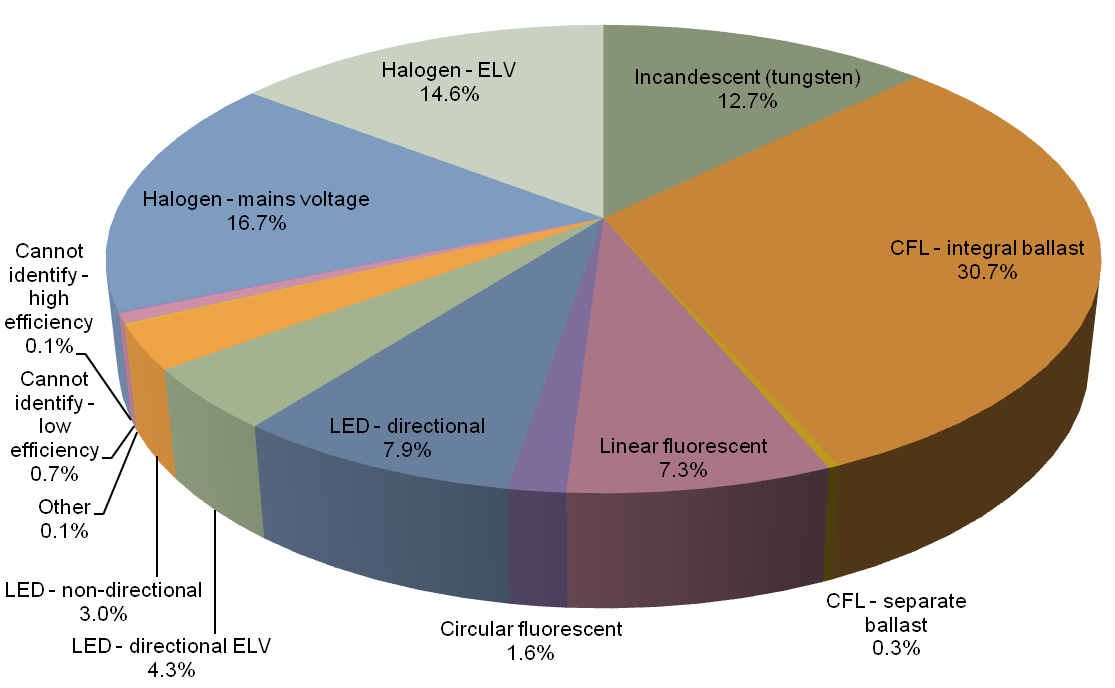
Further more detailed analysis of the data is given in the report, along with a comparison with the data from the 2010/11 audit and overall conclusions about the trends in household usage and the potential for further energy savings.
Although the results of these surveys are specific to the Australian situation, the reports provide insights into the methodology and questioning protocol for these types of survey and may be of interest to policymakers considering these types of investigation in their own country.
To download copies of the reports from the Australian Energy Rating website, click here for the Household Lighting Consumer Survey report and click here for the 2016 Residential Lighting Report.
Status of the ASEAN SHINE - Lighting project
In April 2015, representatives of the energy agencies of the ten Association of Southeast Asian Nations (ASEAN) member countries agreed to work together on the development and implementation of regionally harmonized lighting standards and policy across ASEAN. The UNEP en.lighten initiative was identified to coordinate this initiative, in close collaboration with the ASEAN Center for Energy, under the framework of the ASEAN Standards Harmonization Initiative for Energy efficiency (ASEAN SHINE).
During the first meeting of ASEAN SHINE - Lighting in February 2016, the ASEAN Energy Efficiency and Conservation Subsector Network (EE&C SSN) (as the Steering Committee of ASEAN SHINE) agreed to integrate lighting as the next product under the ASEAN SHINE platform, along with air conditioners (currently being managed by the International Copper Association).
The overall objective of the ASEAN SHINE - Lighting project is to increase energy security and reduce greenhouse gas emissions in ASEAN by transforming the lighting market toward high efficiency products. To achieve this, ASEAN SHINE - Lighting is seeking to harmonize relevant test and performance standards for lighting products among ASEAN Member States, as well as establishing robust supportive policies.
Members of the ASEAN SHINE - Lighting Technical and Policy Working Group at its first meeting

Since this initial meeting, ASEAN SHINE - Lighting has established a Lighting Technical and Policy Working Group, made up of policy and technical experts from the ASEAN Member States, which met in May and July to discuss the ASEAN SHINE - Lighting harmonization process. After presentations on the results from a recent lighting market assessment of the ASEAN region, the Lighting Policy and Technical Working Group members selected linear fluorescent lamps as first priority and non-direction light emitting diode (LED) lamps as second priority for action. LED lamps are a priority for the ASEAN Plan of Action for Energy Cooperation (APAEC) 2016-2025 and linear fluorescent lamps command a large market share across ASEAN and therefore large gains can be made for relatively minor changes.
The next Lighting Policy and Technical Working Group meeting will be held in October 2016, when the definition of in-scope products will be finalised. We will continue to keep lites.asia members up to date on the project as it progresses.
LED lighting projected to reduce power consumption in India by 5%
As a result of continuing economic development in areas such as infrastructure, housing, highways and manufacturing, India has been facing a power shortage for many decades. The current gap of around 8%-10% every year between power supply and demand is only expected to increase as more, electricity consuming, gadgets come into operation.
Against this scenario, ELCOMA, the Electric Lamp and Component Manufacturers Association of India, which represents the entire lighting industry in India, prepared a plan in 2014 which aims to reduce power consumption from lighting from the present 18% of total power consumption to 13% within the next five to six years.
The plan, known as the Vision 2020 Program, specifies a seven year implementation programme which is designed to bring about this reduction in power consumption via a transition to efficient lighting products which use light emitting diodes (LEDs). It proposes:
- Replacing all street lighting with LED street lights;
- Encouraging the use of LED lamps in most lighting sockets; and
- Ensuring that all shops and showrooms use LED down lights instead of incandescent lamps and halogen down lights.
To support the development of this plan, ELCOMA conducted a study in 2014 of the historic, current and projected lighting consumption and lighting point population in India. The key findings of this study are shown in the table below.
Historic, current and projected lighting consumption and lighting point population in India
Based on this data, it was estimated that replacing 40 million street lights and 1.2 billion lighting sockets with LED lighting, would permit savings of around 27,000 MW of power.
The plan was presented to the Indian Government in September 2014 and in December 2014, Prime Minister Shi Narendra Modi announced a commitment to government initiatives to increase awareness of energy conservation and to ensure that all government installations replace existing lighting equipment with LED lighting. This was followed by commitments to replace all street lighting in India with LED street lights within the next four years and to replace all domestic lighting sockets with LED lamps under government schemes to be launched through Energy Efficiency Services Limited (EESL).
Key initiatives from the Vision 2020 Program, which include making all standards mandatory during 2017, are shown in the diagram below, along with the timetable for their implementation.
Vision 2020: Roadmap for ELCOMA
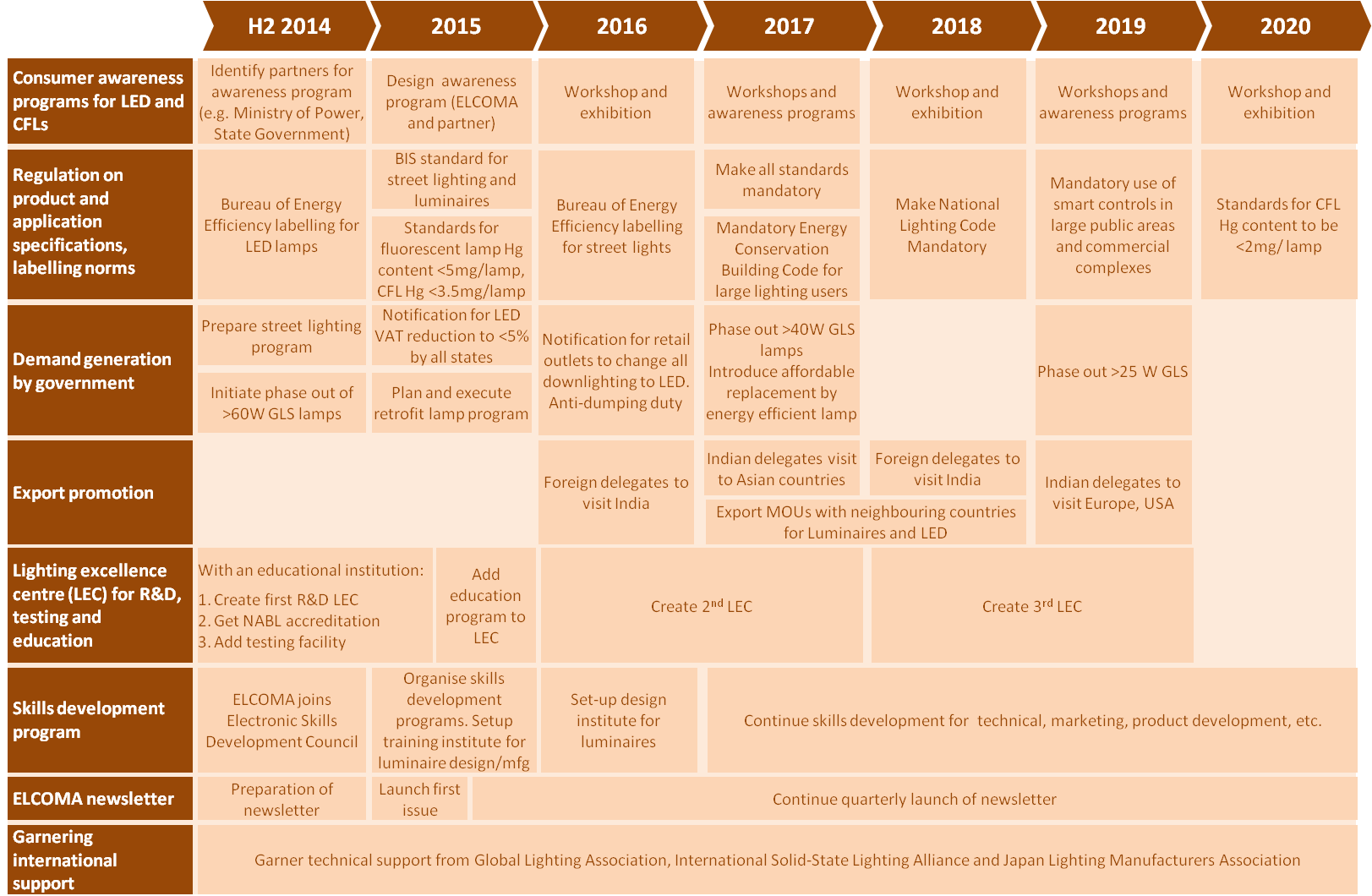 For a larger version of this diagram, click here.
For a larger version of this diagram, click here.
The government initiative, which began at the start of 2015, has already replaced more than 10 million LED lamps and 1 million street lights. It is expected that this number will increase to about 770 million LED lamps and 30 million street lights by end of 2018. The lighting industry is gearing up to step up production for these products to meet government procurement demand. Having grown by about 18% in 2015, it is expected to grow further by 22% in 2016. To finance the street lights programme, EESL is following the energy services company methodology and will recover the cost from municipalities for next seven years against the amount being saved on energy conservation.
For more information on the Vision 2020 programme, click here.
IEC TC 34 explores restructuring for the future
TC 34 is the IEC technical committee responsible for preparing international standards for lamps and related equipment, such as glow starters; lamp caps and holders; lamp control gear and luminaires, and for planning the strategic direction for the standards within its control. It has four subcommittees that are tasked with various technical areas.
For some time, TC 34 has been exploring how to develop itself as ‘fit for the future’. The advisory group reviewing this presented its report at the TC 34 meeting in Denver in October 2015. This highlighted necessary changes but, as the advisory group remit did not include investigations into how these were to be implemented, the committee voted to establish two additional groups:
- Ad Hoc Group 3 (AHG/3), which will consider the internal structure of TC 34; and
- A standing Advisory Group (AG/4), which will consider how TC 34 should engage with relevant groups outside TC34, such as those responsible for smart lighting, communications, protocols.
Both AHG/3 and AG/4 consist of volunteer national committee members and their report with proposals will be discussed at at the next TC 34 meeting, scheduled for October 2016, in Frankfurt, Germany, being held in conjunction with the 2016 IEC General Meeting.
lites.asia members will be kept up to date with information on this restructuring exercise via future issues of the newsletter and ad hoc news alerts.
Proposed New United States Standard for General Service Lamps
In March 2016, the United States Department of Energy proposed a new lighting standard, Proposed Standard for General Service Lamps, which would apply to general service lamps, including light emitting diode and compact fluorescent lamps, sold in the United States starting in 1 January 2020. This standard would not apply to incandescent lamps, which will instead need to meet the congressionally mandated minimum efficiency level or ‘backstop’ specified in the 2007 Energy Independence and Security Act, which would also start in 2020. The standard does not extend to reflector (small diameter directional) lamps.
The proposed standard defines minimum efficacy level curves for lamps in two primary classes – 310 to 2,000 lumens (the vast majority of lamps) and 2,000 to 2,600 lumens and allows about 0.5 watts additional power for lamps that are ‘standby capable’. The graph shows the efficacy targets for the four commonest lamps. For lamps emitting 2,000 to 2,600 lumens, the proposed efficacy limit is about 75 lumens per watt, and no limits are proposed for lamps emitting over 2,600 lumens.
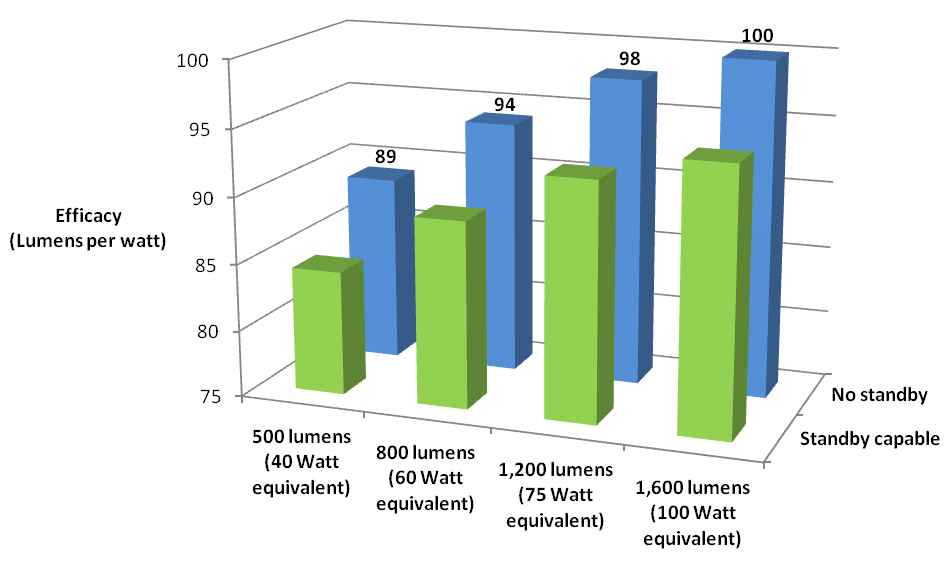
The Department of Energy estimates that the new standard would the increase in average efficiency of the overall lamp market from 82 to about 97 lumens per watt, resulting in lifetime energy savings (compared to a no-new-standards scenario) for general service lamps purchased in the 30-year period from 2020 to 2049 of around 249 terawatt hours. Over the same period the greenhouse gas emissions reduction is estimated at 52 million tonnes of carbon dioxide, 28.2 thousand tonnes of sulphur dioxide, 83.2 thousand tonnes of nitrogen oxides, 195.4 thousand tonnes of methane, 0.58 thousand tonnes of nitrous oxide, with an associated reduction of 0.1 tonnes of mercury. The cumulative reduction in carbon dioxide emissions from 2020 to 2030 amounts to 14.5 million tonnes, which is equivalent to the emissions resulting from the annual electricity use of 1.3 million homes.
The details of the proposed standard were released in a Notice of Proposed Rulemaking, which is a formal, comprehensive document that states exactly what the proposed standard for general service lamps will consist of, along with a Technical Support Document, which provides the complete technical justification for the Standard. In addition, two Excel spreadsheets were provided for the national impacts analysis and the shipments analysis, which provide all the underlying data and assumptions.
Release of the Notice of Proposed Rulemaking marks the start of the formal rulemaking process for the standard. To view an outline of the full process and to download the documents relating to the proposal from the Department of Energy’s Energy Efficiency and Renewable Energy website, click here. For a concise summary of the background to the proposal and what’s included, click here.
Practical guidance and tools for effective monitoring, verification and enforcement
activities

Commissioned as part of its Southeast Asia and Pacific Monitoring, Verification and Enforcement Project, with funding from the Australian Government, the UNEP-GEF en.lighten initiative has produced a range of practical tools to support the development of an effective compliance framework to support energy efficiency policies. These include:
- A series of six guidance notes which focus on individual aspects of an effective monitoring, verification and enforcement (MVE) infrastructure and give best practice guidance and examples for its implementation;
- A prototype registration system to illustrate the capabilities and highlight the benefits of product registration systems. The prototype enables those who wish to implement a fully operational system to do so more quickly and easily because they have a model on which to base their system;
- Two short infographic videos highlighting the importance, and benefits, of MVE and describing the key steps for implementing a MVE programme.
A summary of the en.lighten Southeast Asia and Pacific Monitoring, Verification and Enforcement Project, and links to the full range of resources prepared under the project, can be found on the lites.asia website by clicking here.
Global Efficiency Medal competition for lighting announced by SEAD
This month, the Super-efficient Equipment and Appliance Deployment (SEAD) Initiative announced its sixth Global Efficiency Medal competition. The competition includes lighting products and will recognise the most energy efficient industrial and outdoor lighting products in two categories (high and low bay luminaires and street lighting luminaires) sold across three regions (Europe, India, and North America). Past competitions followed a winner-take-all approach. However, for this competition, in addition to recognising the winning products, all entrants that meet the competition’s minimum criteria will receive recognition. Winners are expected to be announced and honored at a global awards ceremony in May or June 2017.
Manufacturers are invited to review the Official Competition Rules and start preparing for the nomination process. The nomination period is expected to open on 12 September 2016. Purchasers and purchase influencers are invited to support the competition and to consider purchasing award winning products by signing a Letter of Support.
The competition is also coordinating with the Global Lighting Challenge (see next item). Manufacturers, purchasers, and purchase influencers participating in the Global Lighting Challenge and SEAD’s Global Efficiency Medal will be part of a high-profile global platform built to recognise public- and private-sector leaders driving the global transition to efficient lighting and cutting global carbon emissions.
For more information, including the Official Competition Rules and Letter of Support, visit the Global Efficiency Medal Lighting Awards webpage.
Global Lighting Challenge pledges pass the eight billion mark
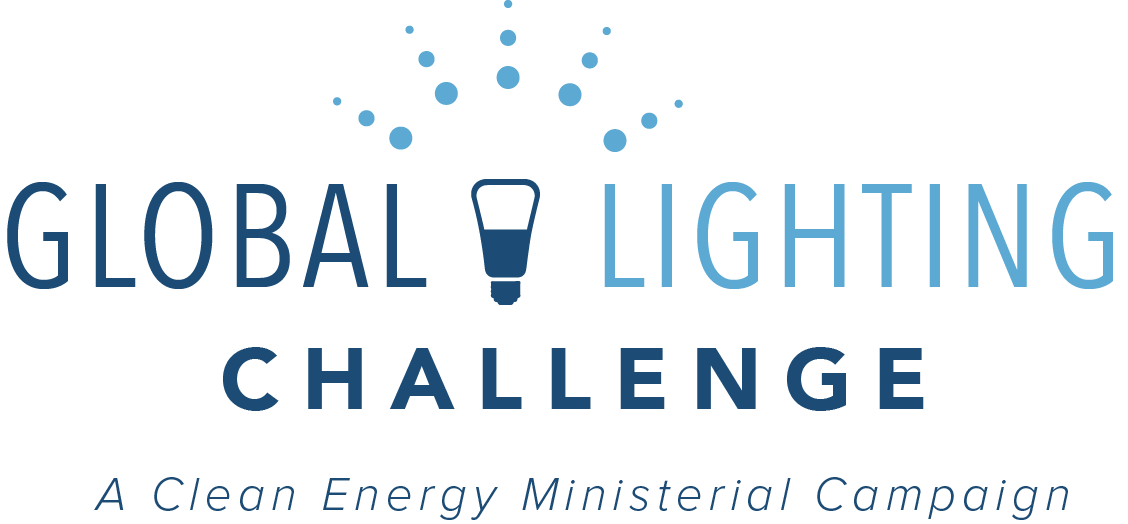 |
At the Seventh Clean Energy Ministerial in San Francisco in June 2016, Nils Vikmång, State Secretary from Ministry of the Environment and Energy in Sweden, and Bill Bien, Head of Strategy of Philips Lighting, announced that the Clean Energy Ministerial’s Global Lighting Challenge has more than eight billion LED lighting products pledged toward the 10 billion goal, and more than 100 million deployed around the world. |
Since its launch in December 2015, the Global Lighting Challenge has built a public-private volunteer coalition of more than 40 governments, manufacturers, retailers, and expert groups working together to accomplish its 10 billion product goal. Most recently, the United Arab Emirates and Canada became the latest countries to join the coalition of governments that have already endorsed and made commitments to the Challenge and, the Vatican, as part of their commitment to protecting the environment, endorsed the Global Lighting Challenge in a letter to the Clean Energy Ministerial. In addition, at the Seventh Clean Energy Ministerial’s Public-Private Action Summit on 2 June 2016, new commitments were made to the challenge by a number of private sector participants and Washington State in the United States.
To find out more about the Global Lighting Challenge and how to participate, click here.

